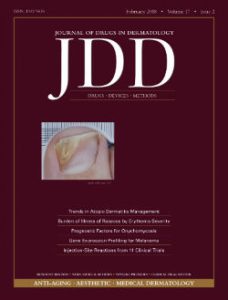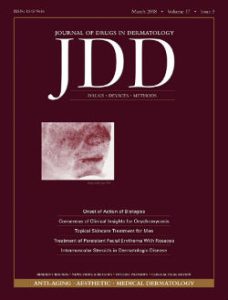Derm In-Review Advisory Council Member, Dr. Ramya Kollipara, searched dermatology journals so that you don’t have to! She reports on important take-aways from different medical journals for the months of January, February, and March of 2018. Find study tools and more like this at Derm In-Review.
It is key to keep in mind that “important” is subjective and what is contained in this review is one person’s opinion.
Best of January 2018
Determination of the Impact of Melanoma Surgical Timing on Survival Using the National Cancer Database
Conic et al. JAAD 2018; 78(1).
Higher risk of mortality associated with stage I melanomas treated after 30 days of biopsy. Surgical timing did not affect survival in stages II and III.
https://www.ncbi.nlm.nih.gov/pubmed/29054718
Location of Skin Lesions in Henoch-Schönlein Purpura and Its Association With Significant Renal Involvement
St. John et al. JAAD 2018; 78(1).
In patients with HSP, skin lesions only on the extremities may be predictive of long-term renal involvement.
https://www.ncbi.nlm.nih.gov/pubmed/29241772
Vitamin D Deficiency in Patients with Alopecia Areata: A Systematic Review and Meta-Analysis
Tsai et al. JAAD 2018; 78(10).
There is a higher prevalence of vitamin deficiency in patient with AA. https://www.ncbi.nlm.nih.gov/pubmed/29241789
Factors Associated With Clinical Remission of Skin Disease
Wolstencroft et al. JAMA Dermatol 2018; 154(1):44-51.
Clinical remission of cutaneous disease is uncommon despite aggressive systemic therapy. Increased age, a dermatomyositis-associated malignancy, and treatment with mycophenolate were associated with clinical remission of skin disease. Patients with anti-MDA-5 antibodies had a lower probability of achieving clinical remission. Disease duration at baseline and before first systemic agent as well as baseline cutaneous disease severity were not associated with clinical remission.
https://www.ncbi.nlm.nih.gov/pubmed/29114741
STAT3 Mediates Nilotinib Response in KIT-Altered Melanoma: A Phase II Multicenter Trial of the French Skin Cancer Network
Deylon et al. JID 2018; 138(1):58-67.
STAT3 levels and its effector (BCL-2, MCL-1) were reduced in patients with KIT altered melanoma treated with KIT inhibitor nilotinib. STAT inhibitors are as effective as KIT inhibitors in reducing cell proliferation in KIT mutated melanomas.
https://www.ncbi.nlm.nih.gov/pubmed/28843487
Best of February 2018
Clinical and Dermoscopic Characterization of Pediatric and Adolescent Melanomas: Multicenter Study of 52 Cases
Carrera et al. JAAD 2018; 78(2).
Nonspitzoid pediatric melanomas were associated with high risk phenotype and pre-existing nevus. Spitzoid melanomas were mostly de novo lesions on the extremities. Less than 25% of pediatric melanomas fulfilled the modified, clinical ABCD criteria. Nonspitzoid melanomas were multicomponent or had nevus-like pattern on dermoscopy while spitzoid melanomas showed atypical vascular patterns with shiny white lines or an atypical pigmented spitzoid pattern.
https://www.jaad.org/article/S0190-9622(17)32475-1/fulltext
Sweet Syndrome in Patients With and Without Malignancy: A Retrospective Analysis of 83 Patients From a Tertiary Academic Referral Center
Nelson et al. JAAD 2018; 78(2).
AML is the most common malignancy associated with Sweet syndrome. Filgrastim was the most common medication. Leukopenia, anemia, thrombocytopenia, absence of arthralgia, and histiocytoid or subcutaneous histopathology were associated with malignancy. https://www.jaad.org/article/S0190-9622(17)32337-X/fulltext
Risk of Developing Pyoderma Gangrenosum After Procedures in Patients With a Known History of Pyoderma Gangrenosum—A Retrospective Analysis
Xia et al, JAAD 2018; 78(2).
There is a small (5.5% of procedures in 15% of patients in study) but significant risk for postsurgical recurrence or exacerbation of PG in patients with a known history of PG. The risk is higher with chronic PG or more invasive procedures.
https://www.jaad.org/article/S0190-9622(17)32445-3/fulltext
Skin Mapping for the Classification of Generalized Morphea
Teske et al. JAAD 2018; 78(2).
Isomorphic (areas of skin friction) generalized morphea occus in older, female patients and often had LSNA changes. Symmetric generalized morphea had involved the reticular dermis, subcutaneous fat and fascia.
https://www.jaad.org/article/S0190-9622(16)30739-3/pdf
Association Between Hypercoagulable Conditions and Calciphylaxis in Patients With Renal Disease: A Case-Control Study
Dobry et al JAMA Dermatol 2018 154(2).
Presence of lupus anticoagulant and associated thrombophilias are risk factors for calciphylaxis in patients with late-stage renal disease. https://jamanetwork.com/journals/jamadermatology/article-abstract/2664344
Best of March 2018
Prevalence and Clinicopathologic Characteristics of Multiple Myeloma With Cutaneous Involvement: A Case Series From Korea
Woo et al JAAD 2018; 78(3).
Cutaneous involvement occurred in 1.14% of patients with multiple myeloma and was associated with reduced overall survival. Erythematous nodules, multiple lesions and absence of grenz zone were associated with reduced overall survival.
https://www.jaad.org/article/S0190-9622(17)32319-8/abstract
Pityrosporum Folliculitis: A Retrospective Review of 110 Cases
Prindaville et al JAAD 2018; 78(3).
Pitysporum folliculitis presents as fine monomorhic pruritic papules and pustules along the hairline and on the upper portion of the back and improves with topical or oral azole antifungal agents.
https://www.ncbi.nlm.nih.gov/pubmed/29138059
Subclinical Sensitization With Diphenylcyclopropenone is Sufficient For the Treatment of Alopecia Areata: Retrospective Analysis of 159 Cases
Choe et al JAAD 2018; 78(3).
A modified DPCP treatment protocol with subclinical sensitization (0.1% for sensitization and then with treatment starting at 0.01% DPCP) leads to a favorable therapeutic response and results in fewer adverse events.
https://www.ncbi.nlm.nih.gov/pubmed/29108907
Association Between Pemphigus and Neurologic Diseases
Kridin et al JAMA Dermatol 2018; 154(3).
An association was observed between pemphigus and dementia, Parkinson disease, and epilepsy.
https://jamanetwork.com/journals/jamadermatology/article-abstract/2672540
Clinical and Immunological Profiles of 14 Patients With Bullous Pemphigoid Without IgG Autoantibodies to the BP180 NC16A Domain
Nakama et al, JAMA Dermatol 2018; 154(30).
BP negative for BP180 antigen has a milder phenotype, fewer erythemas and required less extensive therapy.
https://jamanetwork.com/journals/jamadermatology/article-abstract/2666799
Bonus Picks From The JDD
Hand-picked by Dr. Adam Friedman, Senior Editor of Derm-In Review (part of ODAC’s “Journal of Drugs in Dermatology (JDD): A Year in Review” lecture)
February
 Increased Prevalence of Cancer in Adult Patients With Psoriasis in the United States: A Claims Based Analysis
Increased Prevalence of Cancer in Adult Patients With Psoriasis in the United States: A Claims Based Analysis
Kimaball et al JDD 17.2 (2018): 180-186.
A total of 179,066 pairs of Ps and Ps-free patients. Prevalence of cancer was higher among Ps patients for ANY TYPE of neoplasm (OR [95% confidence interval (CI)]=1.86 [1.83; 1.89]
-
- Malignant skin neoplasms (OR [95% CI]=1.87 [1.79; 1.95])Malignant neoplasms (OR [95% CI]=1.53 [1.49;1.57]).
http://jddonline.com/articles/dermatology/S1545961618P0180X/1
Prevalence of Psoriasis in Children and Adolescents in the United States: A Claims-Based Analysis
Paller et al JDD 17.2 (2018): 187-194.
4.3 million enrolled in their healthcare plan in 2015 and < 18 years of age. The prevalence of Ps was estimated at 128 cases per 100,000 individuals (95% CI: 124-131)
-
-
- Moderate-to-severe Ps at 16 cases per 100,000 individuals (95% CI: 15-17) in 2015.
- Higher in females than in males
- (146 per 100,000 vs. 110 per 100,000 and 17 per 100,000 vs. 15 per 100,000)
http://jddonline.com/articles/dermatology/S1545961618P0187X/1
-
Trends in Atopic Dermatitis Management: Comparison of 1990-1997 to 2003-2012
He et al JDD 17.2 (2018): 135-140.
990,000 annual visits for AD from 2003-2012. TCS were the most frequently used medication (59% of visits). Antihistamines were second among all other physicians (16-44% of visits). Unlike other medications, use of TCIs decreased over time.
http://jddonline.com/articles/dermatology/S1545961618P0135X/1
March
 Intramuscular Steroids in the Treatment of Dermatologic Disease: A Systematic Review
Intramuscular Steroids in the Treatment of Dermatologic Disease: A Systematic Review
Thomas et al JDD 17.3 (2018): 323-329.
62 papers were reviewed and met criteria
-
-
- Diseases: SLE, Behcets, nail LP, AA
- 342 patients
-
- Conclusions: Appropriate dosing q4-6 weeks. Side effect profiles appear to be safer in most instances, with the exception of increased dysmenorrhea in females and lipoatrophy. No hyperglycemia or cushingoid features. Head to head PO vs IM needed.
- http://jddonline.com/articles/dermatology/S1545961618P0323X/1
Stay tuned for the next delivery of our Journal Review Series: April, May & June 2018!

